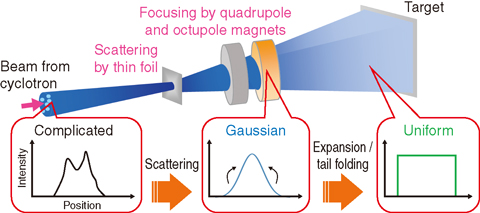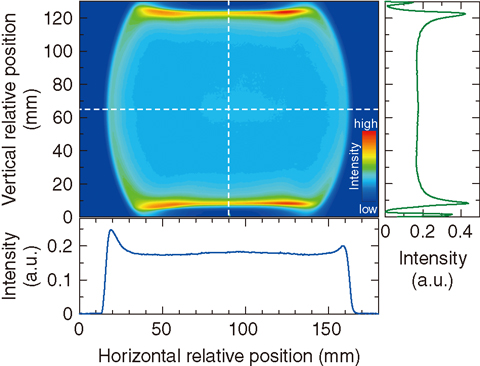
Fig.5-36 Formation procedure of a large-area uniform beam at the TIARA cyclotron

Fig.5-37 Measurement result of the intensity distribution of a large-area uniform beam
It is necessary to uniformly irradiate a large-area sample or many samples with a beam for research and development, and industrial applications using ion beams. We have developed a large-area uniform ion irradiation technique, which is different from a conventional beam scanning technique, to advance quantum beam science research at the cyclotron in TIARA (Takasaki Ion Accelerators for Advanced Radiation Application). This technique is based on the principle that the tail of a beam with a Gaussian intensity distribution can be folded back inside by the nonlinear force produced with octupole magnets and eventually the distribution can be made uniform. This enables advanced uniform irradiation such as short-time and ultralow fluence irradiation, which is difficult or inefficient with the conventional method, since the beam has a large-area uniform intensity distribution.
To realize the formation and irradiation of such a uniform beam, the behavior of ion beams in the magnetic field has been theoretically analyzed and numerically simulated, so as to determine the proper beam transport condition and field gradients of octupole magnets. Then, the formation procedure of the uniform beam was experimentally established as follows.
As shown in Fig.5-36, first the complicated intensity distribution of a beam extracted from the cyclotron is transformed into a Gaussian distribution, which is a prerequisite for uniform-beam formation, by scattering the beam with thin foil. Then, the beam is focused nonlinearly by a combination of quadrupole and octupole magnets.
In beam scattering, the optimum condition of a foil material and its thickness was determined to reduce the beam energy loss that affects the beam utilization. In the beam formation, we achieved the beam optics by which the aspect ratio of the beam profile could be significantly changed. In this way, the formation and irradiation of a large-area uniform beam were realized using various ions species, from protons to xenon. A typical example of a uniform beam is shown in Fig.5-37. The intensity distribution of the beam was obtained by irradiating a radiochromic film, which exhibits a color change due to radiation exposure. The uniformity (standard deviation of the fluence variation) was 7% in the central area of 120 cm2.
Such uniform beams have been applied to quantum beam science research. A radiation degradation test of space-use solar cells is ongoing, since the uniform beam irradiation can be made closer to the radiation field in the actual space environment. Moreover, the chemical modification of fluorine polymers is studied using short-time and in-air irradiation.
In the future, available ion species for uniform irradiation will be increased and the quality of the beam will be improved for industrial applications.